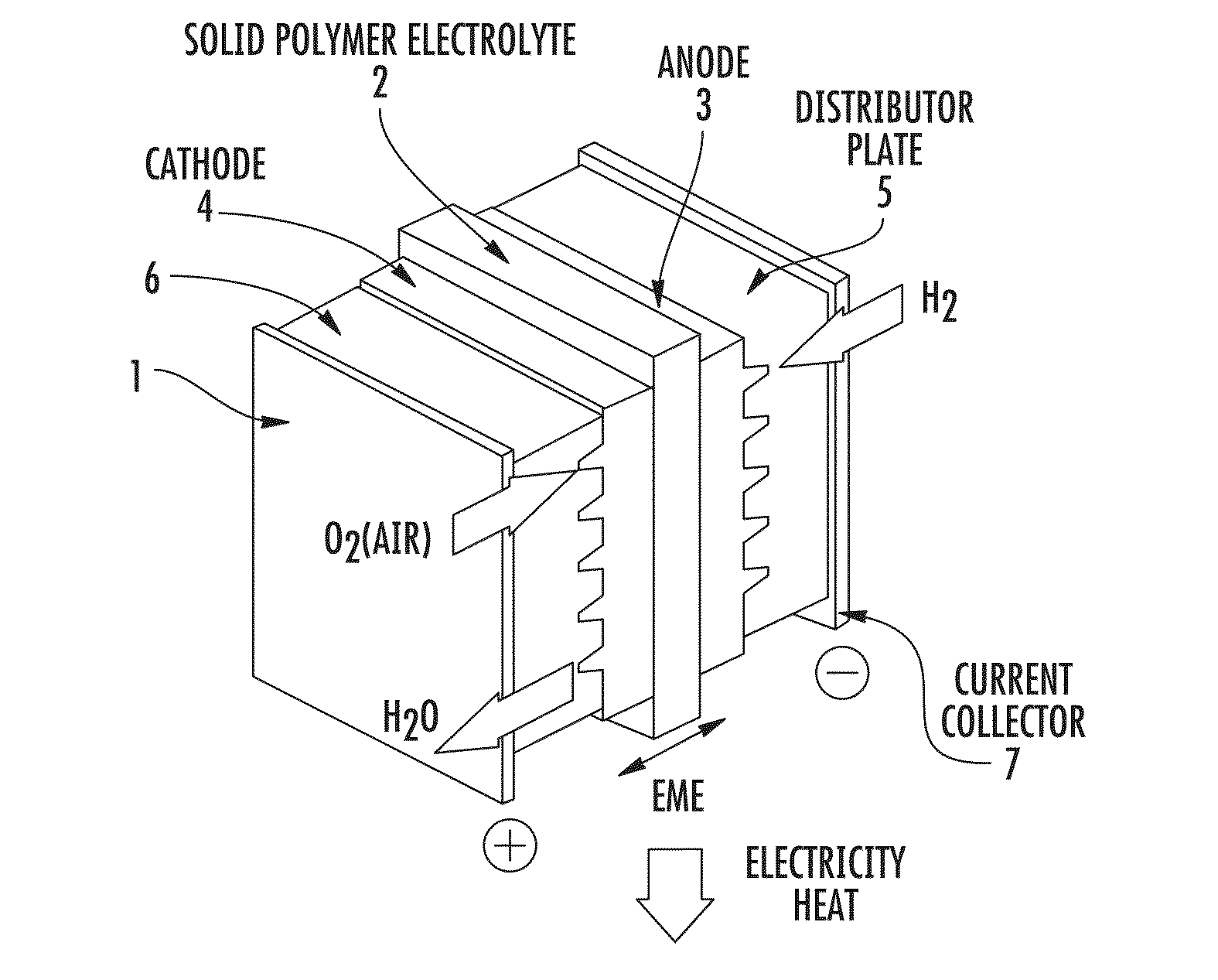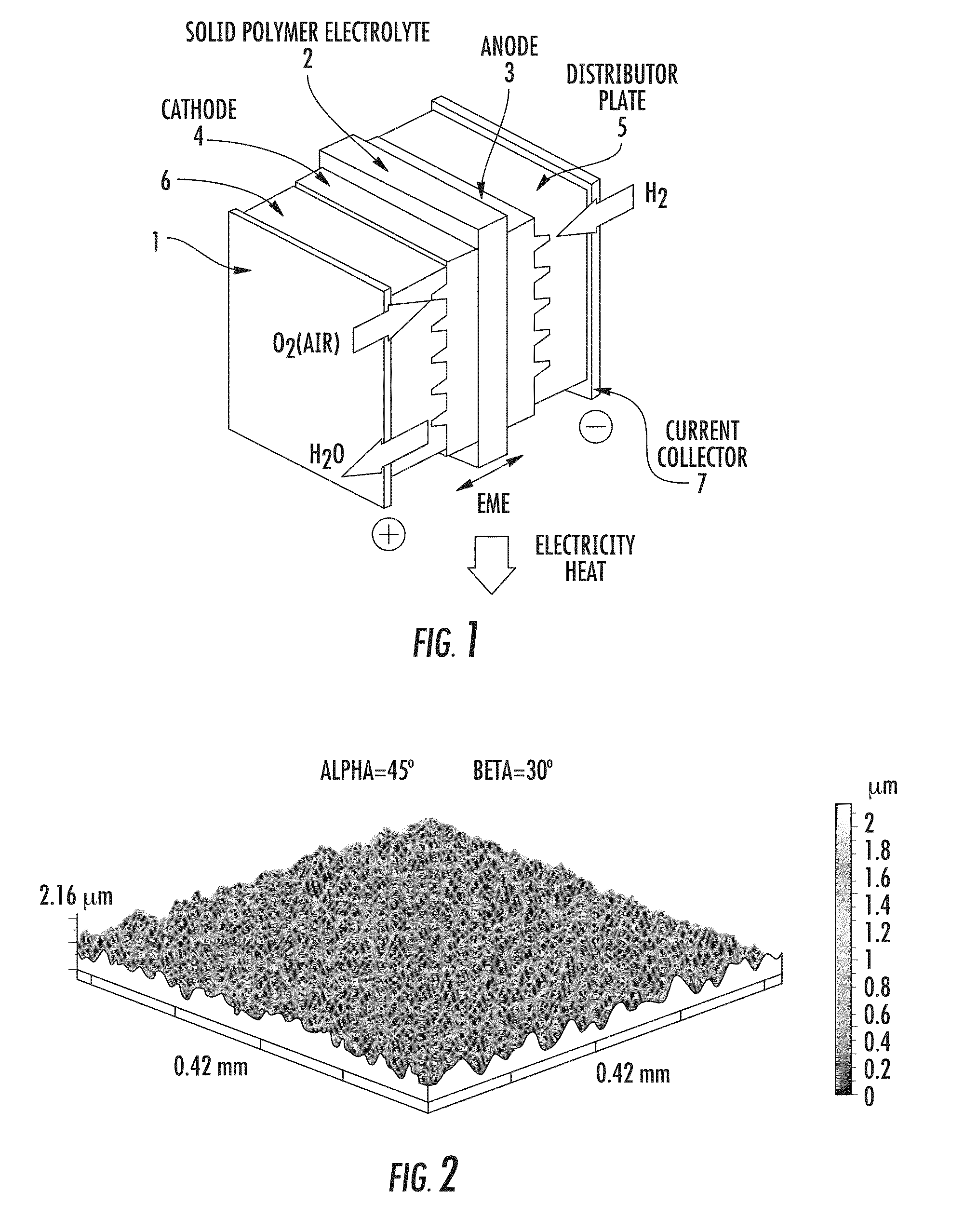Conducting plates for fuel cell elements
a technology of conductor plates and fuel cells, applied in the direction of cell components, final product manufacturing, sustainable manufacturing/processing, etc., can solve the problems of low electrical surface resistance, cost economic compatibility, low electrical resistance of materials, etc., to achieve simple and less expensive methods, satisfying lifetime and compactness, and low electrical resistance
- Summary
- Abstract
- Description
- Claims
- Application Information
AI Technical Summary
Benefits of technology
Problems solved by technology
Method used
Image
Examples
example 1
Manufacture of a Surfaced Alloy Sheet According to the Invention
[0097]A surfaced sheet was manufactured from the alloy SUPERIMPHY® SY286 from Imphy Alloys, the precise composition of which was:[0098]24.43% nickel[0099]14.79% chromium[0100]2.14% titanium[0101]1.46% molybdenum[0102]0.306% vanadium[0103]0.037% carbon[0104]1.71% manganese[0105]0.085% silicon[0106]0.168% aluminium[0107]at most 0.0005% sulphur[0108]0.015% phosphorus.
[0109]To do this, a hot-rolled sheet with a thickness of 4 mm was used, which was cold-rolled in several passes with an intermediate annealing treatment between each cold-rolling pass, so as to obtain a strip thickness of around 0.2 mm. After the last rolling pass, the strip was annealed according to the invention at 1080° C. in an open combustion continuous furnace 27 m in length at a run speed of 20 m / min, the oxygen content in the reducing atmosphere being about 8%. The strip obtained was then pickled by passing it through three successive baths:[0110]Bath ...
example 2
Evaluation of the Surface Finish as a Function of the Sheet Manufacturing Process
[0114]FIG. 2 illustrates the surface finish of a sheet manufactured under conditions similar to those of example 1, which appears to consist of a multitude of bumps. Its surface is characterized by an arithmetic mean roughness Sa of 0.186 μm, a maximum height amplitude St of 2.16 μm and a developed surface area Sdr of 0.344%. FIG. 3 illustrates, for comparison, a sheet manufactured from the same SUPERIMPHY®. SY286 alley by a process that involves an annealing step in a reducing atmosphere, the surface of which has a succession of protuberances. The surface of this sheet is further characterized by an arithmetic mean roughness Sa of 0.106 μm, a maximum height amplitude St of 1.04 μm and a developed surface area Sdr of 0.0767%.
[0115]Furthermore, as is apparent from FIGS. 4 and 5, the surface topographies displayed by scanning electron microscopy, of the sheet according to the invention and the sheet annea...
example 3
Evaluation of the Electrical Surface Resistance as a Function of the Nature of the Alloy
[0117]The electrical contact resistance of three surfaced alloy sheets, having received the same surface treatment, consisting of the alloy grades F17TNb, A286 (alloy SY286) and 316L respectively, were compared as a function of the assembly pressure exerted on each of these sheets in order to join them to an identical diffusion layer.
[0118]The results illustrated in FIG. 6 show that the A286 alloy sheet used according to the invention offers the lowest contact resistance and therefore the best conducting capability.
[0119]A similar measurement was carried out using non-surfaced sheets of SY286 alloy and 904L alloy, which contain similar quantities of nickel.
[0120]FIG. 7 shows that, for two different types of gas diffusion layer (GDL), the contact resistance obtained with alloy SY286 is, here again, the lowest.
[0121]From these experiments it is clear that the alloy used according to the invention i...
PUM
| Property | Measurement | Unit |
|---|---|---|
| height amplitude | aaaaa | aaaaa |
| arithmetic roughness Sa | aaaaa | aaaaa |
| temperature | aaaaa | aaaaa |
Abstract
Description
Claims
Application Information
 Login to View More
Login to View More - R&D
- Intellectual Property
- Life Sciences
- Materials
- Tech Scout
- Unparalleled Data Quality
- Higher Quality Content
- 60% Fewer Hallucinations
Browse by: Latest US Patents, China's latest patents, Technical Efficacy Thesaurus, Application Domain, Technology Topic, Popular Technical Reports.
© 2025 PatSnap. All rights reserved.Legal|Privacy policy|Modern Slavery Act Transparency Statement|Sitemap|About US| Contact US: help@patsnap.com



